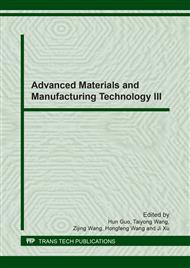p.303
p.312
p.323
p.333
p.342
p.351
p.361
p.370
p.376
The Cutting Parameter Optimization in Helical Milling of Ti Alloys with Small Diameter Tools and the Study of their Cutting Performance
Abstract:
Titanium alloys are widely used in modern aircraft manufacturing. The hole-making technology with high quality becomes a crucial aspect of aircraft assembly. Helical milling process has drawn much attention due to its high machining quality and efficiency. In this work, the cutting performance of small diameter tools (3mm) in helical milling Ti alloy is studied. The parameters of spindle speed, tangential feed speed and pitch (axial feed per revolution) are optimized to reduce cutting force and processing time. The evolutions of the cutting force, burr size, hole side wall roughness and diameter with increasing hole number are investigated. Results show that burr size and hole side wall roughness are much lower than the requirement of aircraft assembly under the optimized parameters of 7000r/min (spindle speeds), 0.1mm (pitch), 0.02mm/tooth (tangential feed). Due to the poor stiffness and large deflection of small diameter tools, excessive hole diameter error is the most prominent problem to be concerned in helical milling process.
Info:
Periodical:
Pages:
342-350
Citation:
Online since:
February 2018
Authors:
Keywords:
Price:
Сopyright:
© 2018 Trans Tech Publications Ltd. All Rights Reserved
Share:
Citation:


